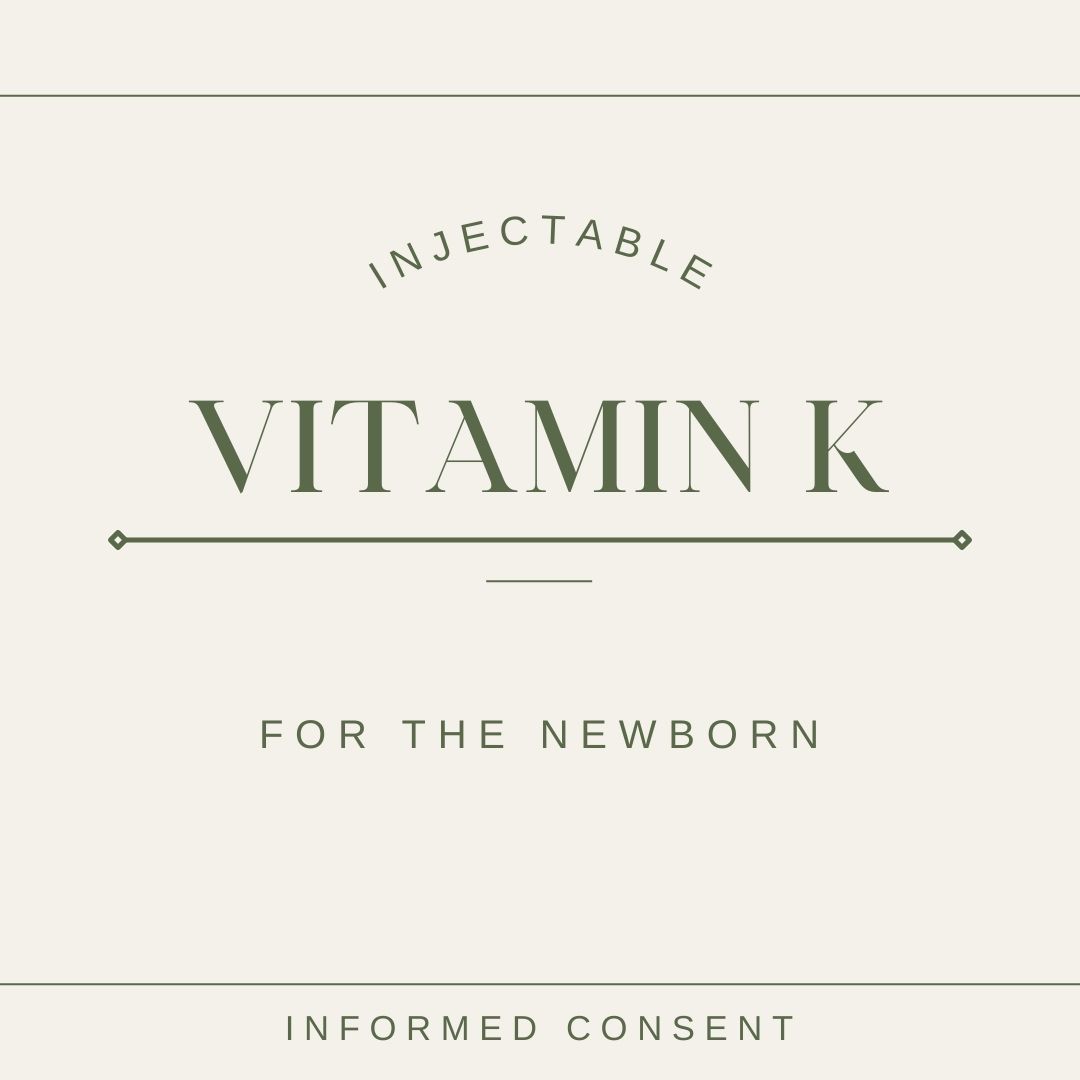Please read the disclaimer.
Two Things
There are two parts to this, but they fit together. First, babies are born Vitamin K deficient. Second, Vitamin K is essential for blood to clot. Lets look at each separately, then put them together to see why it is recommended that all babies are given Vitamin K after they are born.
The Problem
Bacteria in our intestines produce Vitamin K during digestion. However, since newborns have never digested any greens, they have not had the opportunity to manufacture the bacteria that produces any Vitamin K. They are born Vitamin K deficient. Eating foods rich in Vitamin K and or supplementing during pregnancy does not cross the placenta. Doing the same while lactating has very poor transfer of Vitamin K to breastmilk. Unless the baby receives a supplement, they will remain deficient until the start eating solid foods.
The problem is Vitamin K is needed for blood to clot. Without a supplement, babies are at risk for developing an internal hemorrhage (dangerous amount of blood loss in the digestive tract, brain, but may present at a circumcision site). The bleeding, called Hemorrhagic Disease of the Newborn (HDN) or Vitamin K Deficiency Bleeding (VKDB) is classified into three categories.
- early onset, the first 24 hours of life
- classic onset, the first week with an incidence of 1-4 in 250 babies having both early or classic onset
- late onset, the first 6 months (before eating solids) with an incidence of 1-2 in 25,000
Because it mostly presents as internal bleeding, it is not usually discovered until organ damage has occurred. It is often fatal.
The Solution

A Vitamin K supplement shortly after the birth has nearly eliminated Hemorrhagic Disease of the Newborn (HDN). It is given as a one time shot in the baby’s thigh. Easy enough? Well, not exactly.
Conversations with Clients
There are many decisions parents have to make for their labor preferences, immediate postpartum and newborn procedures, with Vitamin K being one of them. The two concerns that come up most with my midwifery and doula clients are about it being really necessary and safety concerns.
I have heard some who believe that there may be a valid reason babies are born Vitamin K deficient, that it may actually benefit them in some way that we have not yet discovered. I have a different opinion, though. A healthy human body looks out for itself by doing what it can to stay healthy and alive. For instance, it will develop a fever to rid an infection or give hunger signals when muscles and organs need fuel. It also wants to make more of itself. Therefore, during pregnancy, the body will switch it’s priority away from itself to the developing fetus. When there is a lack of dietary Calcium, the body will leach it our of the bones and send it through the placenta to give that mini me what it needs. Once the baby is born, the body will go back to prioritizing it’s own needs. For example, if there are not enough nutrients in the diet, it will hoard what is available and not make enough milk to feed the baby. Vitamin K is not necessary for fetal development, but it may needed to prevent postpartum hemorrhage.
Should You Do It?
That’s up to you. Using the BRAIN acronym to gather the information you need for an informed decision may look something like this:
Benefits; prevents internal bleeding for up to six month
Risks; pain at injection site
Alternatives; oral Vit K just as effective for early/classic onset, better than nothing for late onset or formula feeding (formula is fortified with Vit K)
Intuition; individual to each family
Not now; no way to determine if or when a baby might have the disorder, organ damage has usually occurred by the time a diagnoses is made
More on the Risks
Notice that the risk listed was pain at the injection site. There could be other very rare problems that might arise due to the way it is administered, such as an infection at the puncture site or cellulitis. The formula for injectable Vitamin K for newborns has been tested for decades (since the 1940s). There have been a few studies over that time (back in the 1990s) that may have found a potential hazard (Leukemia), but with further testing has shown not to be the case. The Vitamin is safe. The other minute ingredients are safe and necessary to keep the vitamin, which is fat soluble, in a water based suspension and keep bacteria from growing in it during storage. The dose is safe. To minimize any trauma to the baby, I have the mother breast feed during administration. They rarely cry.
An Alternative
I carry injectable Vitamin K and it is included with the midwifery care package. For those who prefer the oral route, drops can be ordered online for around $30. There are multiple forms of Vitamin K. The kind that is specific for blood clotting is K1. Other forms of Vitamin K do not help with VKDB in newborns. Dosage is important. The drop should contain no more than 1 mg per drop.
The usual regimen from some other countries that routinely use oral Vitamin K is as follows:
- 2-4 drops after first breast feed
- 2 drops 2-4 week
- 2 drops 6-8 weeks
Organizations in the US, including the CDC and American Academy of Pediatrics (AAP) do not recommend oral Vitamin K. There is concern that the doses will not be given as directed at home as it is understandable that sleep deprived parents are forgetful. It is shown to be ineffective for late onset VKDB, and countries that use the oral route do have higher incidences of late onset VKBD. It is not regulated by the FDA, thereby dosing cannot be guaranteed. Bilirubin issues have occurred in infants given too much.
For more detailed information on the evidence on injectable and oral Vitamin K, I recommend the article in Evidence Based Birth.
The Center for Disease Control has a virtual Vitamin K info pack here
Healthy Children is developed by the American Academy of Pediatrics, their Position Statement is here
Updated November 2023 to add questions from clients.
Q&A
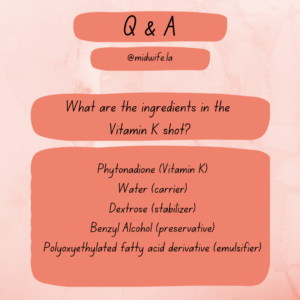
While discussing the Vitamin K shot for their newborn, a client asked what the ingredients were. Well, Vitamin K, of course. A preservative and emulsifier. Specifically, though, I really didn’t know. I had some homework to do. Here is what I found:
The primary ingredient is polyoxyethylated fatty acid derivative. Vitamin K is fat soluble, meaning it doesn’t mix with water. If you have ever made your own vinaigrette, you know how you must shake the mixture before every use due to the oil and vinegar separating. Polyoxyethylated fatty acid derivative is an emulsifier. It makes it so the Vitamin K will stay mixed in a water base. This is needed for the blood stream to be able to get it from the muscle after it is injected.
Next is phytonadione, the Vitamin K itself. The synthetic form Vitamin K1 is used. The natural form of Vitamin K1 is phylloquinone and is found in leafy green vegetables. Supplements from natural sources are usually sourced from algae, and are taken orally. Vitamin K1 supplement that is not given orally, can be given parenterally or by IV, (intravenous), IM (intramuscular), or subcutaneous (under the skin). Remember, the Vitamin K shot is given in a thigh muscle. Therefore, it will be the synthetic version.
Then we have dextrose in water. Dextrose is a sugar or carbohydrate. It keeps the emulsion (remember polyoxyethylated fatty acid derivative from above) stable, keeps it from separating. It’s how store bought vinaigrettes stay mixed. The water is the carrier liquid for the entire solution.
A little bit of benzyl alcohol is added to keep any bacteria from contaminating the solution. Yes, it’s a preservative.
It may contain hydrochloric acid for pH adjustment.
Know Your Vaccines goes over the ingredients and why they are included. The author also gives the amounts of the ingredients and common everyday examples for comparison. The best part is the source section at the bottom of the page. It includes safety data for each ingredient.
Updated again Feb 2025 to add more information about ingredients in the injectable Vitamin K as I have been asked about a preservative free formula. Injectable Vitamin K comes in two options, a single dose ready made syringe and a single dose ampule to draw up into my own syringe.
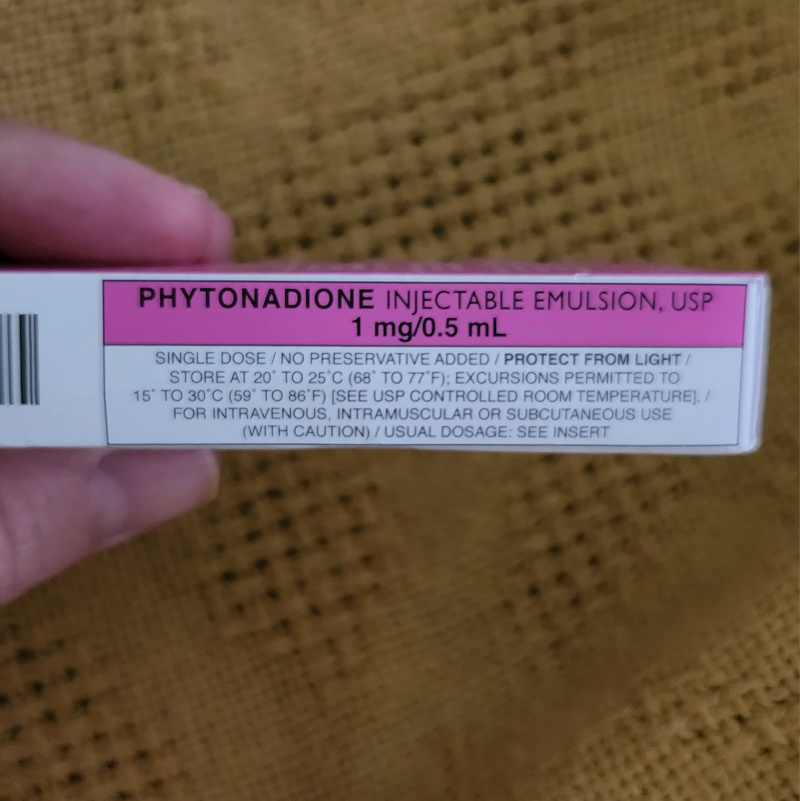
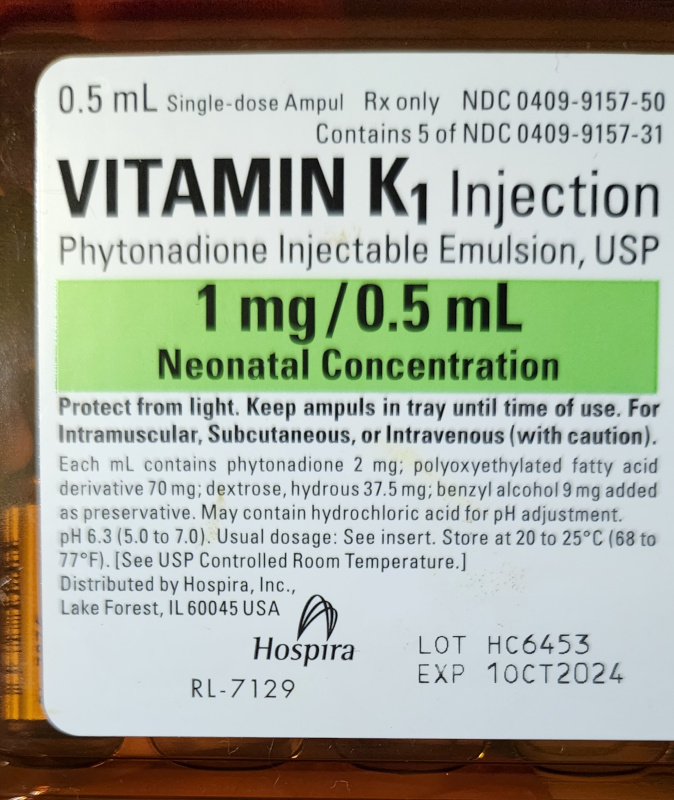
The ingredients listed for the injectable emulsion is listed on my distributors website. It states: “1 mg phytonadione, 10 mg polysorbate 80, 10.4 mg propylene glycol, 0.17 mg C, and 0.00002 mL glacial acetic acid. All pharmaceuticals have chemicals added to the main ingredient to preserve them so as to inhibit bacterial growth and to maintain a longer shelf life.”
Here is a breakdown of the ingredients as the are different from above.
- As mentioned above, the phytonadione is the Vitamin K.
- Polysorbate 80 is an emulsifier, it keeps the fat soluble Vitamin mixed with the water base so the body can utilize it. Polysorbate 80 does not build up in our bodies, being completely eliminated within a few hours.
- Propylene glycol has miscibility properties, meaning it can keep the solution of water ant fat from separating. It does not bioaccumulate. It is fully out of the body after 2 days.
- Propylene glycol has miscibility properties, meaning it can keep the solution of water ant fat from separating. It does not bioaccumulate. It is fully out of the body after 2 days.
- Glacial acetic acid is the “preservative” as it inhibits bacterial growth, working much like vinegar. Vinegar is diluted acetic acid. It leaves the body in a few hours.
The ingredients for the ampules are addressed above.
I think discussion around “preservative free” may come from concerns over thimerosal, a methylmercury found in some vaccines (not pediatric, except for some flu vaccines). There is no thimerosal in Vitamin K. However, there is no injectable Vitamin K that is preservative free.
Updated June 2024 for another question from clients.
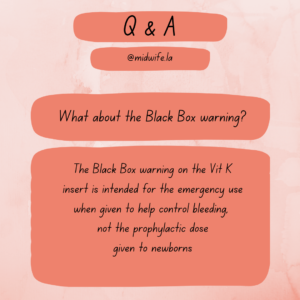
One of my clients had a question regarding the safety of the Vitamin K given to newborns, specifically citing the Black Box warning that is on the label. A follow up question from her was if a gave it subcutaneously. A picture with the concerning parts highlighted she sent me is below.
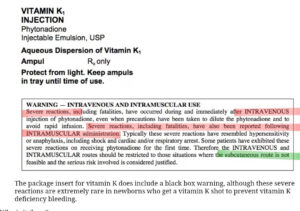
First, I want to acknowledge how terrifying it is to be faced with the decision of giving your baby this shot and have them possibly die, or refusing to give them this shot and have them possibly die.
Yes, these adverse reactions have occurred when Vitamin K is given in large, doses rapidly as a treatment to stop uncontrolled bleeding, usually seen in patients on blood thinners. The large doses are pushed into the body quickly, usually through IV (intravenous). The dosage given is between 2.5 mg and 10 mg, and is repeated over time.
These adverse reactions have not been seen in newborns given the pediatric dose of 1 mg. The pediatric dose is given only once. It is given IM and not subcutaneously since the dose is small,
In summary, the Black Box warning is for medical workers to not overdose hemorrhaging patients. It does not apply to the pediatric use for preventing hemorrhages. Additionally, the treatment for a baby with organ bleeding is higher dosing of Vitamin K through an IV.
More on the Black Box warning for Vitamin K is here. In the reference section at the bottom of the Black Box page, the link to seven myths is broken, but I found it here.


